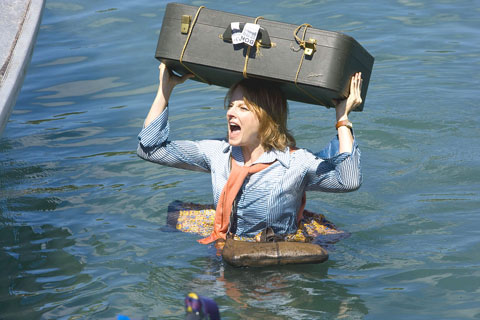A pair of heroines on opposite sides of the world team up in an eye-filling and heartwarming story from Walden Media, the latest in its series of fine films based on popular children’s literature.
Eleven-year-old Nim (Abigail Breslin of Little Miss Sunshine) and her marine biologist father, Jack (Gerard Butler), are the only human residents of a remote but idyllic South Pacific island. While Jack studies nanoplankton, Nim makes the entire island her school, with the animals as her teachers and her friends. Every few months, a supply boat brings another book by her favorite author, Alex Rover, an international man of adventure.
But Alex is really Alexandra (Jodie Foster), a writer so terrified of just about everything that she lives on canned soup, constantly sanitizes her hands, and cannot get far enough outside her front door to retrieve the mail. Alexandra has created a hero who is everything she is not — fearless and always eager to go where he has never been and to try what he has never tried.

PHOTOS COURTESY OF LONG SHONG
To get information for her new book, Alexandra e-mails Jack for details about a volcano he described in an article for National Geographic. But he is away for two days obtaining plankton samples, so Nim answers, thinking she is corresponding with the dashing Alex (also played by Butler, as envisioned by both Alexandra and Nim). By the time Alexandra realizes she is writing to an 11-year-old, Jack is missing and Nim is alone on the island. And the woman who was terrified to walk one meter to the mailbox must go halfway around the world to help her new friend.
Husband-and-wife directors Jennifer Flackett and Mark Levin seamlessly combine adventure, drama, comedy and fantasy as Jack, Nim and Alexandra have to confront their separate but often parallel fears and challenges. As Nim tightens the rope around her waist so that she can climb the volcano, Alexandra is tightening the belt of her robe and gathering her resolve to walk out the front door. All three of them find their determination tested and creativity challenged. And all find assistance from unexpected friends.
Nim is an enormously appealing heroine, and it is especially welcome to have a story about a resourceful and courageous young girl. The film wisely makes her the center of the story in a way that young audiences will find empowering, and Breslin’s unaffected interactions with the creatures and her natural screen presence are a pleasure to watch.

Of the three characters, Nim is closest to the imaginary Alex Rover, confident and capable. She navigates the island by gliding on zip wires like a modern-day Tarzan. She not only swims with the sea lion, she also teaches it to play soccer and boogie. She can fix the solar panels on the roof to get the electricity and satellite uplink back in working order, protect the newborn baby turtles from predators, rappel down the side of a volcano, and make a dinner out of mung beans and mealworms. When the island is invaded by a pirate-themed cruise ship bearing pina coladas, beach chairs, port-a-potties and chubby Australian tourists, Nim and her animal friends set up a Home Alone-style series of booby traps to scare them away.
Butler is fine as Nim’s fond, if distracted father and as the heroic Alex. And it is a treat to see Foster enjoying a comic turn in her first film for families since her Disney days, when she was Nim’s age, and shared the screen with Oscar-winning star Helen Hayes in Candleshoe. Here’s hoping when it is time for Breslin to pass on the torch to a young actress 30 years from now, it will be in a movie as good as this one.

There is a Chinese Communist Party (CCP) plot to put millions at the mercy of the CCP using just released AI technology. This isn’t being overly dramatic. The speed at which AI is improving is exponential as AI improves itself, and we are unprepared for this because we have never experienced anything like this before. For example, a few months ago music videos made on home computers began appearing with AI-generated people and scenes in them that were pretty impressive, but the people would sprout extra arms and fingers, food would inexplicably fly off plates into mouths and text on

From censoring “poisonous books” to banning “poisonous languages,” the Chinese Nationalist Party (KMT) tried hard to stamp out anything that might conflict with its agenda during its almost 40 years of martial law. To mark 228 Peace Memorial Day, which commemorates the anti-government uprising in 1947, which was violently suppressed, I visited two exhibitions detailing censorship in Taiwan: “Silenced Pages” (禁書時代) at the National 228 Memorial Museum and “Mandarin Monopoly?!” (請說國語) at the National Human Rights Museum. In both cases, the authorities framed their targets as “evils that would threaten social mores, national stability and their anti-communist cause, justifying their actions

On the final approach to Lanshan Workstation (嵐山工作站), logging trains crossed one last gully over a dramatic double bridge, taking the left line to enter the locomotive shed or the right line to continue straight through, heading deeper into the Central Mountains. Today, hikers have to scramble down a steep slope into this gully and pass underneath the rails, still hanging eerily in the air even after the bridge’s supports collapsed long ago. It is the final — but not the most dangerous — challenge of a tough two-day hike in. Back when logging was still underway, it was a quick,

US President Donald Trump’s threat of tariffs on semiconductor chips has complicated Taiwan’s bid to remain a global powerhouse in the critical sector and stay onside with key backer Washington, analysts said. Since taking office last month, Trump has warned of sweeping tariffs against some of his country’s biggest trade partners to push companies to shift manufacturing to the US and reduce its huge trade deficit. The latest levies announced last week include a 25 percent, or higher, tax on imported chips, which are used in everything from smartphones to missiles. Taiwan produces more than half of the world’s chips and nearly all